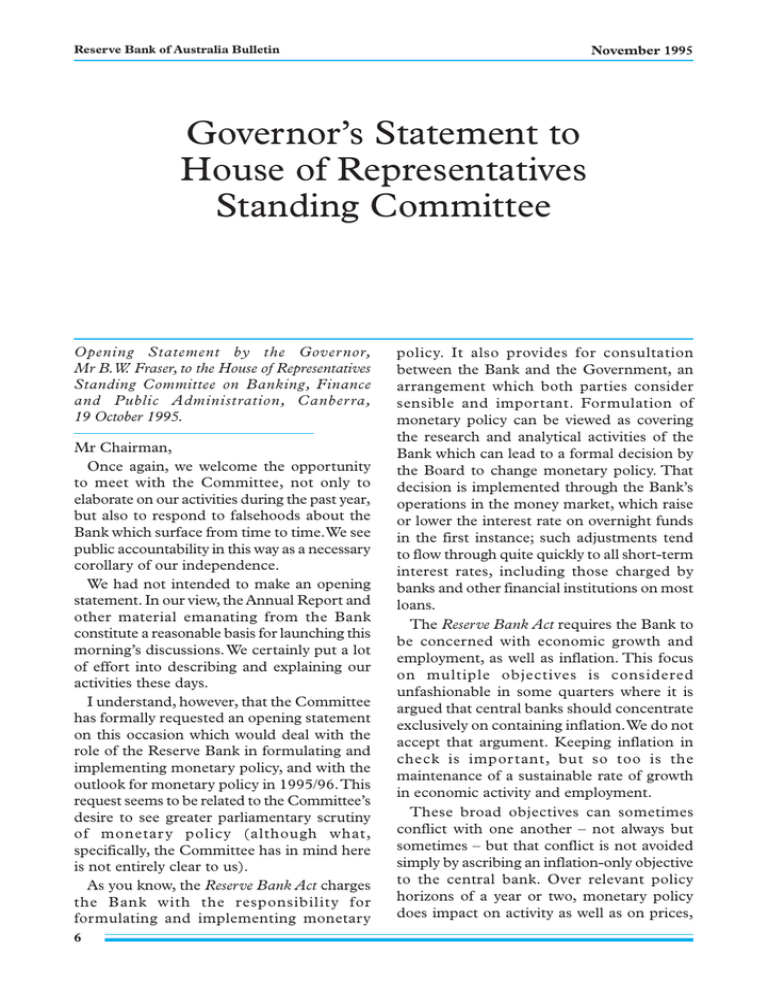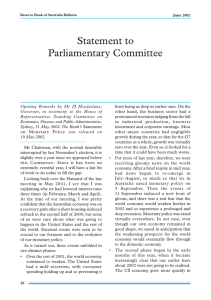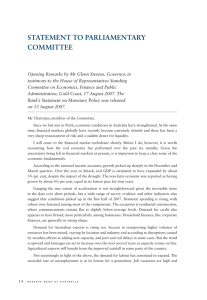Governor’s Statement to House of Representatives Standing Committee
advertisement

Reserve of Australia Governor’sBank Statement to House Bulletin of Representatives Standing Committee November 1995 Governor’s Statement to House of Representatives Standing Committee Opening Statement by the Gover nor, Mr B.W. Fraser, to the House of Representatives Standing Committee on Banking, Finance and Public Administration, Canber ra, 19 October 1995. Mr Chairman, Once again, we welcome the opportunity to meet with the Committee, not only to elaborate on our activities during the past year, but also to respond to falsehoods about the Bank which surface from time to time. We see public accountability in this way as a necessary corollary of our independence. We had not intended to make an opening statement. In our view, the Annual Report and other material emanating from the Bank constitute a reasonable basis for launching this morning’s discussions. We certainly put a lot of effort into describing and explaining our activities these days. I understand, however, that the Committee has formally requested an opening statement on this occasion which would deal with the role of the Reserve Bank in formulating and implementing monetary policy, and with the outlook for monetary policy in 1995/96. This request seems to be related to the Committee’s desire to see greater parliamentary scrutiny of monetar y policy (although what, specifically, the Committee has in mind here is not entirely clear to us). As you know, the Reserve Bank Act charges the Bank with the responsibility for formulating and implementing monetary 6 policy. It also provides for consultation between the Bank and the Government, an arrangement which both parties consider sensible and important. Formulation of monetary policy can be viewed as covering the research and analytical activities of the Bank which can lead to a formal decision by the Board to change monetary policy. That decision is implemented through the Bank’s operations in the money market, which raise or lower the interest rate on overnight funds in the first instance; such adjustments tend to flow through quite quickly to all short-term interest rates, including those charged by banks and other financial institutions on most loans. The Reserve Bank Act requires the Bank to be concerned with economic growth and employment, as well as inflation. This focus on multiple objectives is considered unfashionable in some quarters where it is argued that central banks should concentrate exclusively on containing inflation. We do not accept that argument. Keeping inflation in check is important, but so too is the maintenance of a sustainable rate of growth in economic activity and employment. These broad objectives can sometimes conflict with one another – not always but sometimes – but that conflict is not avoided simply by ascribing an inflation-only objective to the central bank. Over relevant policy horizons of a year or two, monetary policy does impact on activity as well as on prices, Reserve Bank of Australia Bulletin and monetary authorities are often called upon to make implicit trade-offs between inflation and employment. If, for example, the rate of inflation were to rise above some targeted range, how quickly it might be brought back within the target range implicitly raises questions of a trade-off with employment and unemployment. And the public is, of course, concerned about shortterm fluctuations in employment. Put in different words, monetary policy can focus on achieving low inflation over the medium term, while also taking into account short-term activity and employment outcomes. For this and other reasons, we are perfectly comfortable with the Reserve Bank’s present ‘charter’. Like other central banks, we have an inflation objective or ‘target’ to help guide monetary policy. This is to hold underlying inflation to 2-3 per cent on average over a run of years. As we have explained on many occasions, this does not mean that underlying inflation should be between 2 and 3 per cent every year; rather, it means that over the cycle the average rate of inflation should be ‘2 point something’. At times it will exceed 3 per cent, just as at times in recent years it was below 2 per cent. Over the year to June 1995, the increase was 2.5 per cent but, as we indicated in the Annual Report, we expect it to exceed 3 per cent over the quarters ahead; the Budget forecast was for a rise of 33/4 per cent in the year to June 1996. We do not view such outcomes as inconsistent with our objective, although achieving that objective obviously requires inflation to return to 2-3 per cent within a reasonable period of time. As well as serving as a guide to the Reserve Bank, the 2-3 per cent objective – which has been endorsed by the Government and the ACTU – performs a useful role in helping to focus public discussion and debate on monetary policy. Given our interest in growth and employment, as well as inflation, in formulating monetary policy we analyse a host of data bearing on developments in those areas, and then come to judgments as to whether or not monetary policy should be November 1995 adjusted. In the Annual Report we commented that ‘finding the appropriate balance between the activity and inflation objectives of monetary policy remains a challenging task’, and that ‘there are risks both ways’. Not much has happened to change those comments in the two months since the Annual Report was tabled. Our latest assessment is contained in the Bank’s October Bulletin, which was released yesterday. I will not, therefore, go into detail here but, in brief, the economy overall appears to be growing at between 3 and 4 per cent; the Budget forecast was for growth of 3 3/ 4 per cent in GDP in 1995/96. Most indicators of consumer spending remain strong while business investment is continuing to grow, although less rapidly than in the past couple of years. Employment growth also has moderated, partly as a lagged reaction to the slowing in activity from the unsustainable pace of 1994. On the other hand, on-going adjustments in the housing sector, and in inventories, are likely to detract from growth in 1995/96. Parts of the world economy also appear to be experiencing some slowing in growth (e.g. Europe), while economic recovery in Japan is still to get underway. It remains to be seen how these divergent forces balance out over the months ahead – in particular, whether, aided by the expected boost to rural incomes, growth bounces back towards (or through) the top end of the 3 to 4 per cent band, or whether it slides towards (or through) the bottom end. Less uncertainty attaches to the outlook for inflation. As I noted earlier, underlying inflation is expected to exceed 3 per cent during this year, propelled in part by higher unit labour costs, consequent upon a pick-up in wages and executive salaries and a cyclical falling off in productivity growth. Looking ahead, slower economic and employment growth should help to moderate recent rates of growth in wages. A stronger exchange rate, and some squeezing of profit margins, would also help to cushion – for a time – the effect of higher labour costs on consumer prices, but could not do so indefinitely. 7 Governor’s Statement to House of Representatives Standing Committee In summary, activity is, if anything, a touch weaker than was envisaged in the Budget forecasts, while wage costs are a touch higher. For the time being, however, current monetary policy settings remain broadly consistent with projected trends in economic growth and inflation. Monetary policy needs to be forward looking, but it needs also to be 8 November 1995 based on considered judgments about likely trends in activity and costs, not short-term movements in particular indicators. Over the months ahead, we will be monitoring closely these trends in coming to judgments as to what changes – if any – need to be made to monetary policy.








